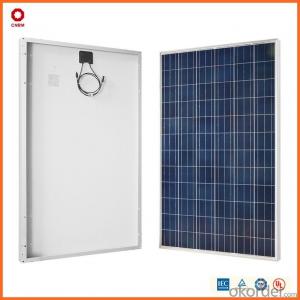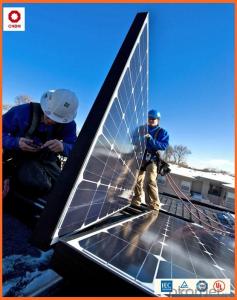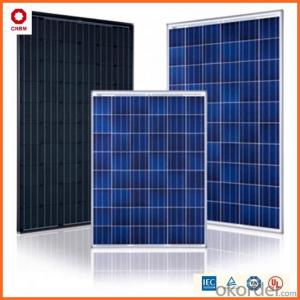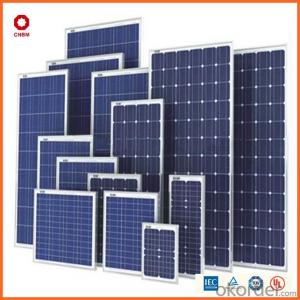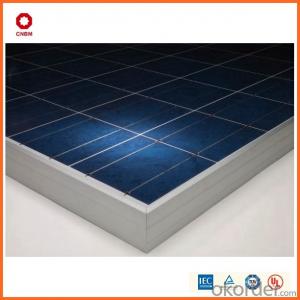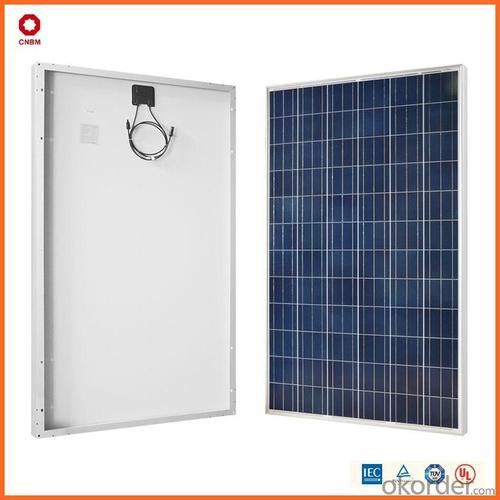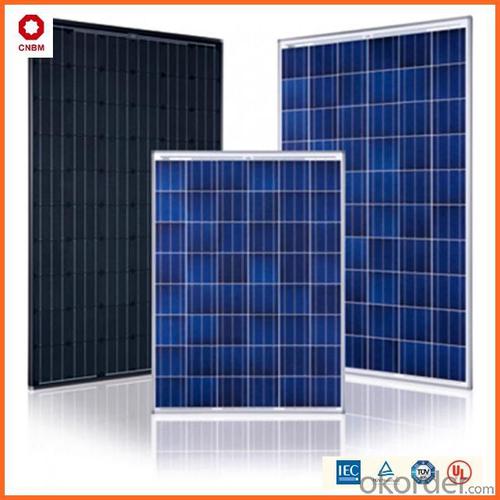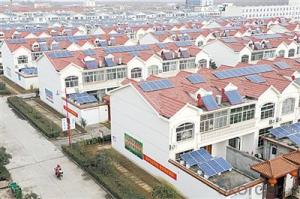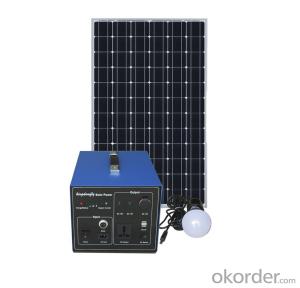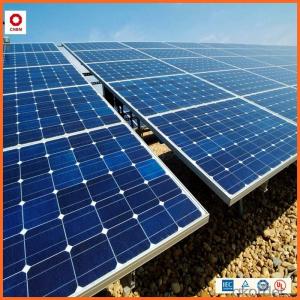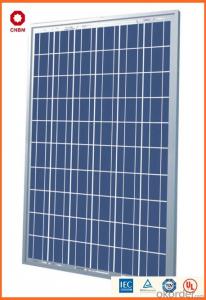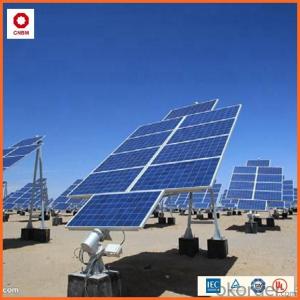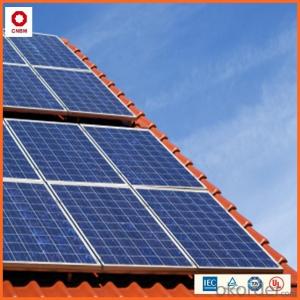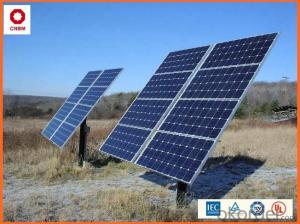Smac Solar Energy Systems - !!! Hot on Sale!!! Stock 310W Poly Solar Panel USD0.46/W A Grade Good Solar Panel on Sale
- Loading Port:
- China main port
- Payment Terms:
- TT OR LC
- Min Order Qty:
- 1 watt
- Supply Capability:
- 10000000 watt/month
OKorder Service Pledge
OKorder Financial Service
You Might Also Like
Product Description:
Hot Sale !!! Quality and Safety of 245w-320w Poly Solar Panel
1. Rigorous quality control meets the highest international standards.
2. High-transmissivity low-iron tempered glass, strong aluminium frame.
3. Using UV-resistant silicon.
4. IS09001/14001/CE/TUV/UL
Warranties of 245w-320w Poly Solar Panel
1. 10 years limited product warranty
2. 15 years at 90% of the minimal rated power output
3. 25 years at 80% of the minimal rated power output
Technical date of 245w-320w Poly Solar Panel
ITEM NO.: | Mono 125*125 cell ,36pcs . Power range from 80Wp-100Wp | ||||||||
Maximum Power(W) | 80 | 85 | 90 | 95 | 100 | ||||
Optimum Power Voltage(Vmp) | 17.81 | 17.89 | 17.94 | 17.99 | 18.06 | ||||
Optimum Operatige Current(Imp) | 4.78 | 4.91 | 5.12 | 5.35 | 5.59 | ||||
Open Circuit Voltage(Voc) | 21.98 | 22.05 | 22.14 | 22.28 | 22.45 | ||||
Short Circuit Current(Isc) | 4.95 | 5.15 | 5.36 | 5.65 | 5.84 | ||||
Solar Cell: | 125*125 Mono | ||||||||
Number of Cell(pcs) | 4*9 | ||||||||
Brand Name of Solar Cells | JA Cell, Bluesun Cell | ||||||||
Size of Module(mm) | 1580*808*35 | ||||||||
Caple & Connector Type | Pass the TUV Certificate | ||||||||
Frame(Material Corners,etc.) | Aluminium-alloy | ||||||||
Backing (Brand Type) | TPT | ||||||||
Cell Efficiency for 100W(%) | 15.8% | ||||||||
Weight Per Piece(KG) | 12.0KG | ||||||||
FF (%) | 70-76% | ||||||||
Junction Box Type | Pass the TUV Certificate | ||||||||
Tolerance Wattage(e.g.+/-5%) | ±3%, or 0-3% | ||||||||
Front Glass Thikness(mm) | 3.2 | ||||||||
Temperature Coefficients of Isc(%) | +0.04 | ||||||||
Temperature Coefficients of Voc(%) | -0.38 | ||||||||
Temperature Coefficients of Pm(%) | -0.47 | ||||||||
Temperature Coefficients of Im(%) | +0.04 | ||||||||
Temperature Coefficients of Vm(%) | -0.38 | ||||||||
Temperature Range | -40°C to +85°C | ||||||||
Surface Maximum Load Capacity | 2400Pa | ||||||||
Allowable Hail Load | 23m/s ,7.53g | ||||||||
Bypass Diode Rating(A) | 12 | ||||||||
Warranty | 90% of 10 years,80% of 25 years. | ||||||||
Standard Test Conditions | AM1.5 1000W/ 25 +/-2°C | ||||||||
Packing | carton or pallet | ||||||||
1*20' | 25 Pallets / 450pcs | ||||||||
1*40'STD | 25 Pallets / 100pcs | ||||||||
Features of our products:
• High conversion efficiency mono/poly-crystalline amorphous silicon solar cells
• Modules incorporate high performance bypass diodes to minimize the power drop caused by shading
• High transmittance, low-iron tempered glass
• High performance EVA encapsulant to prevent destroying and water.
• AI frame: without screw, corner connection. 8 holes on the frame can be installed easily
• Good performance of preventing from atrocious weather such as wind and hails
• Certifications: CE IEC TUV VDE UL, Class I
• 10 years 90% power output warranty

Shipping of 245w-320w Poly Solar Panel
By Sea | Delivery from Shanghai or Ningbo seaport |
By Air | Departure from Shanghai Pudong Airport |
By Express | Post by DHL, EMS, UPS, TNT. |
- Q: How do solar energy systems impact energy efficiency measures?
- Solar energy systems can greatly improve energy efficiency measures. By harnessing the power of the sun, solar energy systems provide clean and renewable energy that reduces reliance on traditional fossil fuels. This helps to decrease overall energy consumption and greenhouse gas emissions. Additionally, solar energy systems can be integrated with energy efficiency measures such as insulation, LED lighting, and smart thermostats to further optimize energy usage and reduce costs. Overall, solar energy systems play a crucial role in enhancing energy efficiency and promoting a sustainable future.
- Q: Can solar energy systems be used for powering off-grid eco-industrial parks?
- Yes, solar energy systems can definitely be used for powering off-grid eco-industrial parks. Solar energy is a renewable and sustainable source of power that can be harnessed through the installation of solar panels. These panels can generate electricity from sunlight, which can then be utilized to power various operations within the eco-industrial park. By relying on solar energy, these off-grid parks can become self-sufficient and reduce their reliance on traditional energy sources, thus promoting environmental sustainability.
- Q: Can solar energy systems be used for powering air conditioning in commercial buildings?
- Yes, solar energy systems can be used to power air conditioning in commercial buildings. Solar panels can generate electricity that can be used to run air conditioning units, reducing the reliance on traditional energy sources and helping to lower energy costs. Additionally, solar energy systems can be integrated with energy storage solutions, allowing for the continuous operation of air conditioning even during periods of low or no sunlight.
- Q: How do solar energy systems affect wildlife and ecosystems?
- Solar energy systems have a minimal impact on wildlife and ecosystems compared to conventional energy sources. While there may be some localized disturbance during the construction phase, once operational, solar energy systems do not emit greenhouse gases or release pollutants that harm ecosystems. Additionally, appropriate site selection, design, and management can mitigate potential impacts on wildlife, such as bird collisions or habitat fragmentation. Overall, solar energy systems offer a cleaner and more sustainable alternative, promoting a healthier environment for wildlife and ecosystems.
- Q: Can solar energy systems be used for recreational vehicles or boats?
- Yes, solar energy systems can be used for recreational vehicles or boats. These systems can provide power for various appliances and electronics, making them suitable for off-grid camping or sailing. Solar panels can be installed on the roof or deck of the vehicle or boat, and the energy generated can be stored in batteries for later use. This allows for a sustainable and convenient power source while enjoying outdoor activities.
- Q: Can solar energy systems be used for powering disaster relief efforts?
- Yes, solar energy systems can be used for powering disaster relief efforts. Solar power provides a reliable and sustainable source of energy, especially in areas where the conventional power grid may be disrupted or unavailable due to a disaster. Solar energy systems can be quickly deployed and can provide electricity to power medical facilities, communication systems, lighting, and other essential equipment during relief operations. They are also cost-effective in the long run and reduce dependency on fossil fuels, making solar energy an ideal solution for disaster-affected areas.
- Q: How do solar energy systems impact water resources?
- Solar energy systems have a minimal impact on water resources compared to other forms of energy production. Unlike traditional power plants that require large amounts of water for cooling, solar power generation does not consume water during operation. This reduces water stress, preserves aquatic ecosystems, and ensures the availability of clean water for other uses like agriculture and drinking. However, the manufacturing process of solar panels and other components might require water, but it is generally much lower compared to the water usage of conventional energy sources. Overall, solar energy systems contribute positively to water conservation and sustainability.
- Q: Are there any risks of theft or vandalism with solar energy systems?
- Yes, there are some risks of theft or vandalism associated with solar energy systems. Solar panels, inverters, and batteries can be attractive targets for thieves due to their high value. Additionally, vandalism can occur, such as intentional damage to solar panels or theft of crucial components. However, there are preventive measures that can be implemented, such as installing security systems, using tamper-proof equipment, and ensuring proper insurance coverage to mitigate these risks.
- Q: Can solar panels be installed on facades or windows?
- Yes, solar panels can be installed on facades or windows. Traditional solar panels are typically installed on rooftops to maximize sunlight exposure. However, there are now innovative solar technologies that allow for the integration of solar panels into building facades or windows. These technologies, known as building-integrated photovoltaics (BIPV) or building-applied photovoltaics (BAPV), enable the use of solar panels as part of the building's design and architecture. BIPV systems can be seamlessly integrated into the building's facade, replacing traditional building materials such as glass or cladding. This allows for the generation of solar energy while maintaining the aesthetic appeal of the building. BAPV systems, on the other hand, involve the installation of solar panels onto existing windows or as window coverings. These panels can be transparent or semi-transparent, allowing natural light to penetrate while generating electricity. Solar panels on facades or windows offer several advantages. Firstly, they provide additional surface area for solar energy generation, making the most of available space in urban environments where rooftop installations might be limited. Secondly, they can help to reduce a building's energy consumption by generating electricity on-site, thereby lowering reliance on the grid. Lastly, they contribute to the overall sustainability and eco-friendliness of the building, promoting renewable energy use and reducing carbon emissions. However, there are some considerations to keep in mind when installing solar panels on facades or windows. Factors such as the building's orientation, shading, and the quality of natural light need to be carefully evaluated to ensure optimal energy production. Additionally, the structural integrity of the building must be assessed to determine if it can support the additional weight of the solar panels. In conclusion, solar panels can indeed be installed on facades or windows through BIPV or BAPV systems. These innovative technologies offer numerous benefits such as increased energy generation, reduced energy consumption, and enhanced building sustainability. However, proper evaluation and planning are essential to ensure the effectiveness and feasibility of such installations.
- Q: What happens to excess solar energy produced?
- Excess solar energy produced can be stored in batteries for later use, fed back into the grid, or utilized to power other devices or systems such as heating or cooling systems.
Send your message to us
Smac Solar Energy Systems - !!! Hot on Sale!!! Stock 310W Poly Solar Panel USD0.46/W A Grade Good Solar Panel on Sale
- Loading Port:
- China main port
- Payment Terms:
- TT OR LC
- Min Order Qty:
- 1 watt
- Supply Capability:
- 10000000 watt/month
OKorder Service Pledge
OKorder Financial Service
Similar products
Hot products
Hot Searches
Related keywords
